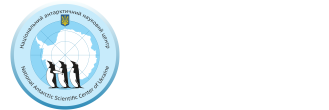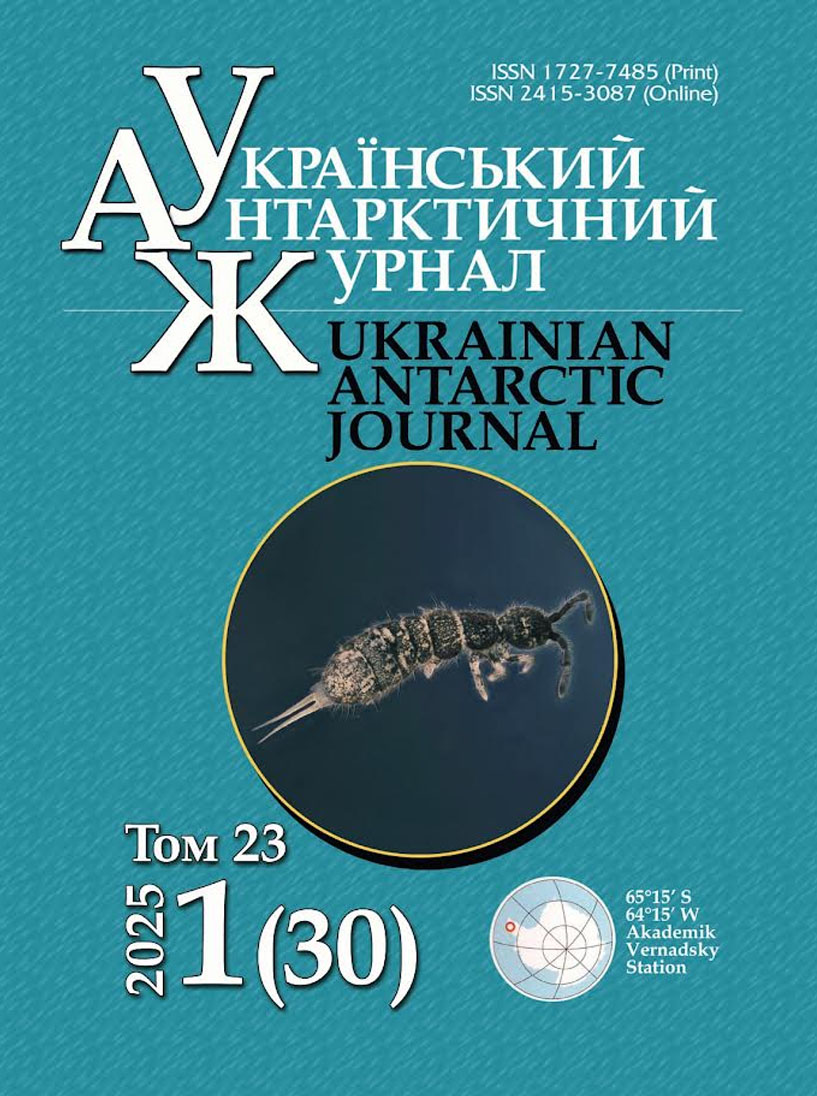- вітрова фільтрація,
- неоднорідна вітрова течія,
- полярна термосфера,
- хвилі в атмосфері
Авторське право (c) 2025 Український антарктичний журнал

Ця робота ліцензується відповідно до Creative Commons Attribution-NonCommercial-NoDerivatives 4.0 International License.
Анотація
Ми дослідили властивості атмосферних гравітаційних хвиль (АГХ) в областях полярних вітрових систем у термосфері з використанням даних супутникових вимірювань. Встановлено, що АГХ систематично поширюються у напрямку від ночі до дня назустріч вітру. Досліджено залежність амплітуди хвиль від швидкості зустрічного вітру. Показано, що у зустрічній неоднорідній вітровій течії амплітуди хвиль зростають за рахунок енергообміну із середовищем. У результаті, саме такі АГХ великих амплітуд переважають у спостереженнях у полярній термосфері. Тому області вітрової течії можна розглядати як джерело енергії для АГХ. Частоти полярних АГХ були визначені за допомогою супутникових вимірювань. Отримані значення частот для різних полярних орбіт супутника Dynamics Explorer 2 є дуже близькими до частоти Брента-Вяйсяля. Це свідчить про фільтрацію хвильового спектру у неоднорідному вітровому потоці. Отримані результати дозволяють пояснити основні спостережувані зі супутника властивості АГХ у полярній термосфері та порівняти їх із наземними вимірами. При співставленні результатів супутникових та наземних вимірювань характеристик АГХ необхідно враховувати фонові атмосферні течії. Так, частоти АГХ, визначені за супутниковими даними, є близькими до частоти Брента-Вяйсяля. Однак наземний спостерігач реєструватиме такі збурення як дуже низькочастотні. Можна припустити, що частина спостережуваних випадків великомасштабних АГХ є середньомасштабними збуреннями, що поширюються на фоні сильних вітрів. При посиленні геомагнітної активност і швидкості полярних вихорів зростають, що супроводжується збільшенням передачі енергії від течії до хвиль у цих областях. Тому АГХ відіграють важливу роль в енергетичному балансі полярної атмосфери, перерозподіляючи енергію збурених вітрових течій у вертикальному напрямку.
Посилання
- Aruliah, A. L., Rees, D., & Fuller-Rowell, T. J. (1991). The combined effect of solar and geomagnetic activity on high-latitude thermospheric neutral winds. Part I. Observations. Journal of Atmospheric and Terrestrial Physics, 53(6–7), 467–483. https://doi.org/10.1016/0021-9169(91)90075-I
- Carignan, G. R., Block, B. P., Maurer, J. C., Hedin, A. E., Reber, C. A., & Spencer, N. W. (1981). The neutral mass spectrometer on Dynamics Explorer B. Space Science Instrumentation, 5, 429–441. https://ntrs.nasa.gov/citations/19820032902
- Crowley, G., & Williams, P. J. S. (1987). Observation of the source and propagation of atmospheric gravity waves. Nature, 328, 231–233. https://doi.org/10.1038/328231a0
- Deng, Y., & Ridley, A. J. (2006). Dependence of neutral winds on convection E-field, solar EUV, and auroral particle precipitation at high latitudes. Journal of Geophysical Research. Space Physics, 111(A9), A09306. https://doi.org/10.1029/2005JA011368
- Fedorenko, A. K. (2009). Determination characteristics of atmospheric gravity waves in the Polar regions using mass-spectrometer satellite measurements. Radio Physics and Radio Astronomy, 14(3), 254–266. http://rpra-journal.org.ua/index.php/ra/article/view/510 (In Ukrainian)
- Fedorenko, A. K., Bespalova, A. V., Cheremnykh, O. K., & Kryuchkov, E. I. (2015). A dominant acoustic-gravity mode in the polar thermosphere. Annales Geophysicae, 33(1), 101–108. https://doi.org/10.5194/angeo-33-101-2015
- Fedorenko, A. K., Kryuchkov, E. I., Cheremnykh, O. K., Klymenko, Yu. O., & Yampolski, Yu. M. (2018). Peculiarities of acoustic-gravity waves in inhomogeneous flows of the polar thermosphere. Journal of Atmospheric and Solar-Terrestrial Physics, 178, 17–23. https://doi.org/10.1016/j.jastp.2018.05.009
- Fedorenko, A. K., Kryuchkov, E. I., Cheremnykh, O. K., & Melnychuk, S. V. (2024). Propagation of acoustic gravity waves in inhomogeneous wind flows of the polar atmosphere. Kinematics and Physics of Celestial Bodies, 40, 15–23. https://doi.org/10.3103/S0884591324010045
- Francis, S. H. (1975). Global propagation of atmospheric gravity waves: A review. Journal of Atmospheric and Terrestrial Physics, 37(6–7), 1011–1030. https://doi.org/10.1016/0021-9169(75)90012-4
- Hajkowicz, L. A. (1991). Auroral electrojet effect on the global occurrence pattern of large scale travelling ionospheric disturbances. Planetary and Space Science, 39(8), 1189–1196. https://doi.org/10.1016/0032-633(91)90170-F
- Harvey, V. L., Randall, C. E., Goncharenko, L. P., Becker, E., Forbes, J. M., Carstens, J., Xu, S., France, J. A., Zhang, S.-R., & Bailey, S. M. (2023). CIPS observations of gravity wave activity at the edge of the polar vortices and coupling to the ionosphere. Journal of Geophysical Research: Atmospheres, 128(12), e2023JD038827. https://doi.org/10.1029/2023JD038827
- Hays, P. B., Killeen, T. L., & Kennedy, B. C. (1981). The Fabry-Perot interferometer on Dynamics Explorer. Space Science Instrumentation, 5(4), 395–416. https://ntrs.nasa.gov/citations/19820032900
- Hines, C. O. (1960). Internal atmospheric gravity waves at ionospheric heights. Canadian Journal of Physics, 38(11), 1441–1481. https://doi.org/10.1139/p60-150
- Hocke, K., & Schlegel, K. (1996). A review of atmospheric gravity waves and travelling ionospheric disturbances: 1982–1995. Annales Geophysicae, 14(9), 917–940. https://doi.org/10.1007/s00585-996-0917-6
- Innis, J. L., & Conde, M. (2002). Characterization of acoustic-gravity waves in the upper thermosphere using Dynamics Explorer 2 Wind and Temperature Spectrometer (WATS) and Neutral Atmosphere Composition Spectrometer (NACS) data. Journal of Geophysical Research: Space Physics, 107(A12), SIA 1-1–SIA 1–22. https://doi.org/10.1029/2002JA009370
- Johnson, F. S., Hanson, W. B., Hodges, R. R., Coley, W. R., Carignan, G. R., & Spencer, N. W. (1995). Gravity waves near 300 km over the polar caps. Journal of Geophysical Research, 100(A12), 23993–24002.
- Killeen, T. L., Won, Y.-I., Niciejewski, R. J., & Burns, A. G. (1995). Upper thermosphere winds and temperatures in the geomagnetic polar cap: Solar cycle, geomagnetic activity, and interplanetary magnetic field dependencies. Journal of Geophysical Research: Space Physics, 100(A11), 21327–21342. https://doi.org/10.1029/95JA01208
- Lighthill, J. (1978). Waves in Fluids. Cambridge University Press.
- Liu, H.-L., Lauritzen, P. H., & Vitt, F. (2024). Impacts of Gravity Waves on the Thermospheric Circulation and Composition. Geophysical Research Letters, 51(3), e2023GL107453. https://doi.org/10.1029/2023GL107453
- Lühr, H., Rentz, S., Ritter, P., Liu, H., & Häusler, K. (2007). Average thermospheric wind patterns over the polar regions, as observed by CHAMP. Annales Geophysicae, 25(5), 1093–1101. https://doi.org/10.5194/angeo-25-1093-2007
- Moffat-Griffin, T. (2019). An introduction to atmospheric gravity wave science in the polar regions and first results from ANGWIN. Journal of Geophysical Research: Atmospheres, 124(3), 1198–1199. https://doi.org/10.1029/2019JD030247
- Nappo, C. J. (2012). An Introduction to Atmospheric Gravity Waves (2nd ed.). Elsevier Science.
- Negale, M. R., Taylor, M. J., Nicolls, M. J., Vadas, S. L., Nielsen, K., & Heinselman, C. J. (2018). Seasonal propagation characteristics of MSTIDs observed at high latitudes over Central Alaska using the Poker Flat Incoherent Scatter Radar. Journal of Geophysical Research: Space Physics, 123(7), 5717–5737. https://doi.org/10.1029/2017JA024876
- Paznukhov, V. V., Sopin, A. A., Galushko, V. G., Kashcheyev, A. S., Koloskov, A. V., Yampolski, Y. M., & Zalizovski, A. V. (2022). Occurrence and characteristics of traveling ionospheric disturbances in the Antarctic Peninsula region. Journal of Geophysical Research: Space Physics, 127(11), e2022JA030895. https://doi.org/10.1029/2022JA030895
- Rourke, S., Mulligan, F. J., French, W. J. R., & Murphy, D. J. (2017). A climatological study of short-period gravity waves and ripples at Davis Station, Antarctica (68 8.S,78.E), during the (austral winter February–October) period 1999–2013. Journal of Geophysical Research: Atmospheres, 122(21), 11,388–11,404. https://doi.org/10.1002/2017JD026998
- Spencer, N. W., Wharton, L. E., Niemann, H. B., Hedin, A. E., Carrignan, G. R., & Maurer, J. C. (1981). The Dynamics Explorer wind and temperature spectro meter. Space Science Instrumentation, 5(4), 417–428. https://ntrs.nasa.gov/citations/19820032901
- Thayer, J. P., Killeen, T. L., McCormac, F. G., Tschan, C. R., Ponthieu, J. J., & Spencer, N. W. (1987). Thermospheric neutral wind signatures dependent on the east-west component of the interplanetary magnetic field for Northern and Southern Hemispheres as measured by Dynamics Explorer-2. Annales Geophysicae Series A – Upper Atmosphere and Space Sciences, 5A. https://ntrs.nasa.gov/citations/19880035781
- Tsugawa, T., Saito, A., & Otsuka, Y. (2004). A statistical study of large-scale traveling ionospheric disturbances using the GPS network in Japan. Journal of Geophysical Research: Space Physics, 109(A6), A06302. https://doi.org/10.1029/2003JA010302
- Williams, P. J. S., Jones, B., & Jones, G. O. L. (1992). The measured relationship between electric field strength and electron temperature in the auroral E-region. Journal of Atmospheric and Terrestrial Physics, 54(6), 741–748. https://doi.org/10.1016/0021-9169(92)90112-X
- Zhang, S.-R., Erickson, P. J., Coster, A. J., Rideout, W., Vierinen, J., Jonah, O., & Goncharenko, L. P. (2019). Subauroral and polar traveling ionospheric disturbances during the 7–9 September 2017 storms. Space Weather, 17(12), 1748–1764. https://doi.org/10.1029/2019SW002325


